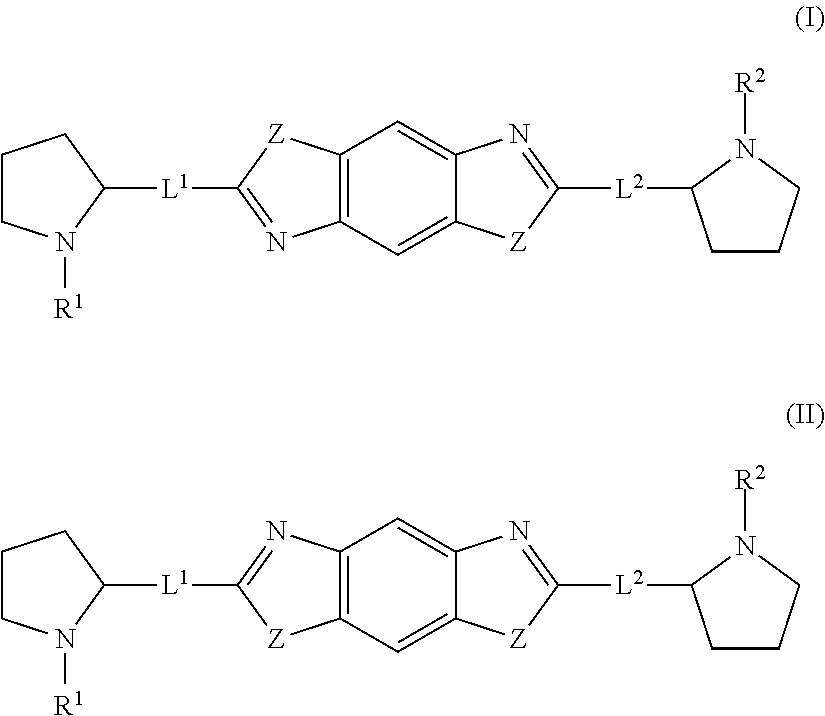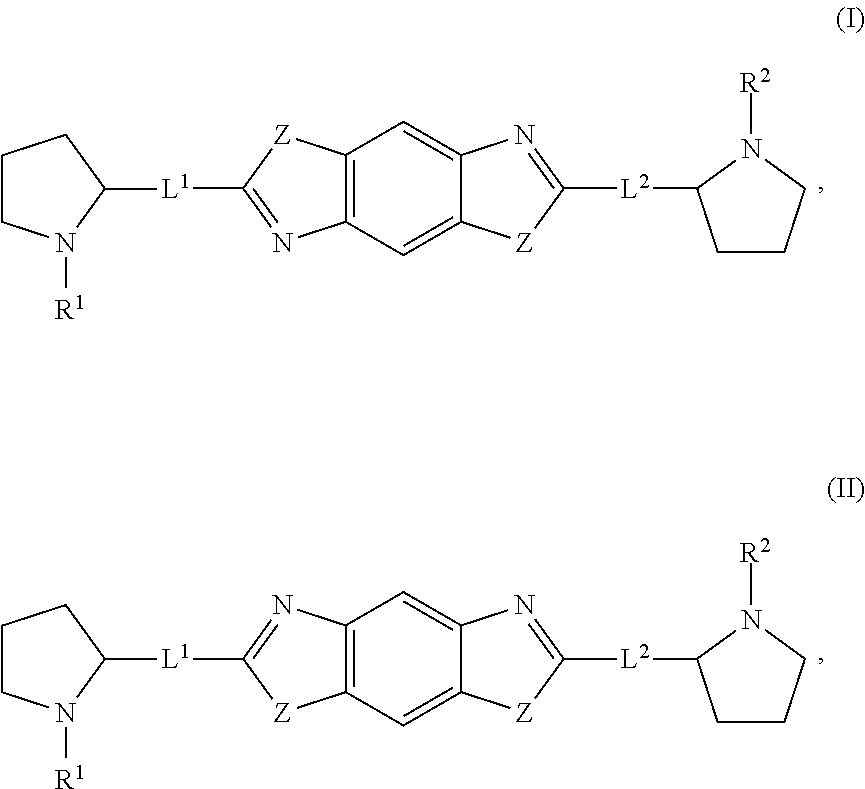Hepatitis C virus inhibitors
a technology of hepatitis c virus and inhibitors, applied in the field of antiviral compounds, can solve the problems of non-optimal success rate in achieving sustained viral response, numerous side effects, and considerable heterogeneity in nucleotide and encoded amino acid sequences, and achieve the effect of inhibiting the function of the hcv ns5a protein
- Summary
- Abstract
- Description
- Claims
- Application Information
AI Technical Summary
Problems solved by technology
Method used
Image
Examples
example 1
Methyl ((1S)-1-(((2S)-2-(4-(6-(2-((28)-1-((2S)-2-((methoxycarbonyl)amino)-3-methylbutanoyl)-2-pyrrolidinyl)-1H-imidazol-4-yl)[1,3]thiazolo[5,4-f][1,3]benzothiazol-2-yl)-1H-imidazol-2-yl)-1-pyrrolidinyl)carbonyl)-2-methylpropyl)carbamate, bistrifluoracetate
[0488]
[0489]HATU (39.7 mg, 0.104 mmol) was added to a stirred solution of 2,6-bis(2-((2S)-2-pyrrolidinyl)-1H-imidazol-5-yl)benzo[1,2-d:4,5-d′]bis[1,3]thiazole (40 mg, 0.044 mmol), (S)-2-(methoxycarbonylamino)-3-methylbutanoic acid (19.1 mg, 0.109 mmol) and DIEA (0.076 mL, 0.44 mmol) in dimethylformamide (2 mL). The reaction was stirred for 4 h at room temperature (incomplete by LCMS) and additional (S)-2-(methoxycarbonylamino)-3-methylbutanoic acid (19.1 mg, 0.109 mmol), DIEA (0.076 mL, 0.44 mmol) and HATU (39.7 mg, 0.104 mmol) were added and the mixture was stirred overnight at room temperature. The reaction mixture was diluted with methanol (2 mL) and water (2 mL), stirred for 15 min at room temperature and concentrated to drynes...
example 2
Dimethyl ([1,3]thiazolo[5,4-f][1,3]benzothiazole-2,6-diylbis(1H-imidazole-4,2-diyl(2S)-2,1-pyrrolidinediyl((1R)-2-oxo-1-phenyl-2,1-ethanediyl)))biscarbamate, bistrifluoracetate
[0491]
[0492]HATU (43.6 mg, 0.115 mmol) was added to a stirred solution of 2,6-bis(2-((2S)-2-pyrrolidinyl)-1H-imidazol-5-yl)benzo[1,2-d:4,5-d′]bis[1,3]thiazole (27 mg, 0.029 mmol), (R)-2-(methoxycarbonylamino)-2-phenylacetic acid (24.6 mg, 0.118 mmol) and DIEA (0.051 mL, 0.29 mmol) in dimethylformamide (2 mL). The reaction was stirred for 16 h at room temperature. The reaction mixture was diluted with methanol (2 mL) and water (2 mL), stirred for 15 min at room temperature and concentrated to dryness in vacuo. The residue was purified by preparative HPLC (acetonitrile / water / 0.1% TFA) to afford dimethyl ([1,3]thiazolo[5,4-f][1,3]benzothiazole-2,6-diylbis(1H′-imidazole-4,2-diyl(2S)-2,1-pyrrolidinediyl((1R)-2-oxo-1-phenyl-2,1-ethanediyl)))biscarbamate, bistrifluoracetate (14.9 mg, 0.014 mmol, 47.4% yield) as a pal...
example 3
Methyl ((1R)-1-(((2S)-2-(4-(6-(2-((2S)-1-((2R)-2-((methoxycarbonyl)amino)-3-methylbutanoyl)-2-pyrrolidinyl)-1H-imidazol-4-yl)[1,3]thiazolo[5,4-f][1,3]benzothiazol-2-yl)-1H-imidazol-2-yl)-1-pyrrolidinyl)carbonyl)-2-methylpropyl)carbamate, bistrifluoracetate
[0494]
[0495]HATU (43.6 mg, 0.115 mmol) was added to a stirred solution of 2,6-bis(2-((2S)-2-pyrrolidinyl)-1H-imidazol-5-yl)benzo[1,2-d:4,5-d′]bis[1,3]thiazole (27 mg, 0.029 mmol), (R)-2-(methoxycarbonylamino)-3-methylbutanoic acid (20.6 mg, 0.118 mmol) and DIEA (0.051 mL, 0.29 mmol) in dimethylformamide (2 mL). The reaction was stirred overnight at room temperature. The reaction mixture was diluted with methanol (2 mL) and water (2 mL), stirred for 15 min at room temperature and concentrated to dryness in vacuo. The residue was purified by preparative HPLC (acetonitrile / water / 0.1% TFA) to afford methyl ((1R)-1-(((2S)-2-(4-(6-(2-((2S)-1-((2R)-2-((methoxycarbonyl)amino)-3-methylbutanoyl)-2-pyrrolidinyl)-1H-imidazol-4-yl)[1,3]thiazolo...
PUM
| Property | Measurement | Unit |
|---|---|---|
| particle size | aaaaa | aaaaa |
| wave length | aaaaa | aaaaa |
| flow rate | aaaaa | aaaaa |
Abstract
Description
Claims
Application Information
 Login to View More
Login to View More - R&D
- Intellectual Property
- Life Sciences
- Materials
- Tech Scout
- Unparalleled Data Quality
- Higher Quality Content
- 60% Fewer Hallucinations
Browse by: Latest US Patents, China's latest patents, Technical Efficacy Thesaurus, Application Domain, Technology Topic, Popular Technical Reports.
© 2025 PatSnap. All rights reserved.Legal|Privacy policy|Modern Slavery Act Transparency Statement|Sitemap|About US| Contact US: help@patsnap.com



